Creating climate solutions in Alaska
Momentum on a range of climate solutions already underway in Alaska may surprise you. And some of the best fixes come from the most remote places.

In Alaska, we combine the power of scientific inquiry and collaborative partnerships to help people and nature thrive.

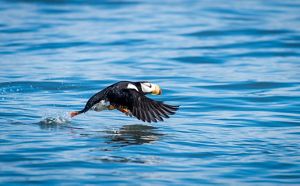




Brown bear waits for salmon: A brown bear waits for sockeye salmon with a seagull friend in Katmai National Park, Alaska. © Tracey Hunnewell

Puffin: A puffin in flight near Lake Clark National Park, Alaska. © James Day/TNC Photo Contest 2018

Hoonah Native Forest: Members of the Hoonah Native Forest Partnership walk to a study site. © Bethany Sonsini Goodrich/SSP

Alaska Playground: Insider Experiences - Alaska's Playground © Alaska Wildland Adventures

Rock sandpiper nest: Rock sandpiper nest on Alaska's Hawadax Island. © Island Conservation
Alaska may be in a time of terrific change, but by coming together in new ways to protect natural places like forests and wetlands we can maximize nature’s ability to store carbon. We’re responding to a growing call for clean, renewable energy to ease pollution and lessen the dependence on fossil fuels in communities across Alaska.





The Last Frontier : Alaska is home to iconic wildlife such as grizzly and black bears and moose—like this mother moose and calves. © Christine Haines/TNC Photo Contest 2021

Tongass National Forest: A path running through the mossy forest floor in the Tongass National Forest of Alaska. © Chris Crisman

Tongass National Forest: Aerial view of Southeast Alaska's Tongass National Forest during flight from Prince of Wales Island to Ketchikan. © Erika Nortemann/TNC

Brown Bear: Brown bear fishing for salmon in Alaska. © Ami Vitale
Discover the ways we're working beyond Alaska to build climate resilience.
We’re protecting Bristol Bay’s salmon stronghold and the subsistence, sport and commercial fisheries it supports. We’re also working to expand access for rural fishing families to participate in and benefit from Alaska’s Limited Entry permit system.
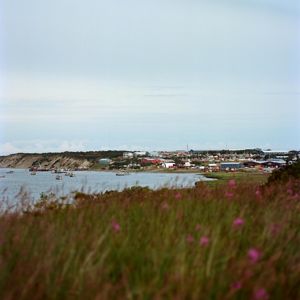

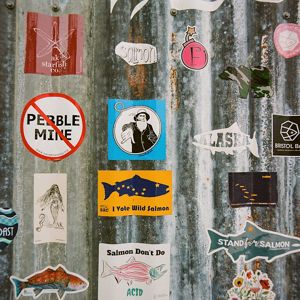


Indigenous Communities: For people in villages like Naknek, one of 26 Indigenous communities in Bristol Bay, the natural abundance of healthy lands & waters contribute to a remarkable way of life. © Brian Adams

Healthy Catch: Bristol Bay is home to the planet’s largest run of wild salmon. © Jason Satoshi Ching

Naknek: Stickers adorn the backyard smokehouse of Carla Harris in Naknek, Alaska. Salmon fishing is a way of life in this small town along Bristol Bay, and many of the businesses within the community are in service to this industry. July, 2019. © Brian Adams

Naknek: A set netting fishing boat in Bristol Bay at sunset off the coast of Naknek, Alaska. Bristol Bay has one of the last great salmon runs in the world. Each summer, towns along Bristol Bay are filled with fishers who earn a significant amount of money for the salmon caught. July, 2019. © Brian Adams
See how we're working across Alaska to protect our state's most precious natural resource.
As Alaska, Native people reclaim Indigenous authority over lands, waters and ways of life. We work “at the speed of trust” in communities where we’re invited to be part of a future that fully respects and honors Indigenous ways of knowing.
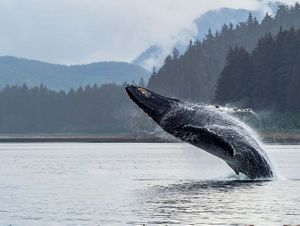
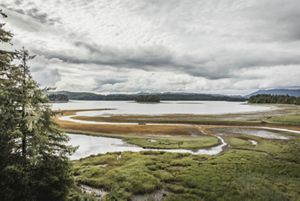
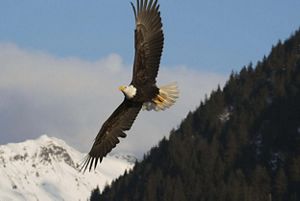


Whale Breach: Humpback whale breaching, near Hoonah AK. © John Overbaugh/TNC Photo Contest 2022

Coffman Cove: Southeast Alaska’s rural communities rely on Tongass’ rivers and streams as a natural pantry, with each resident consuming an average of 75 pounds of salmon a year. © Chris Crisman

Soaring Above the Mountains: An American Bald Eagle is soaring over Kachemak Bay, Alaska. I had the opportunity to travel with a photography team to witness the migration of eagles in March, 2018. © C. Denise Maples/TNC Photo Contest 2019

Camp connections: Paulette Jackson, an adult leader at the Kake Culture Camp in Kake, Alaska, leads youth from one activity to the next. © Bethany Sonsini Goodrich
Learn more about our work with Indigenous partners.
You Can Join Us.
See how we're stepping up progress for people and nature in Alaska.